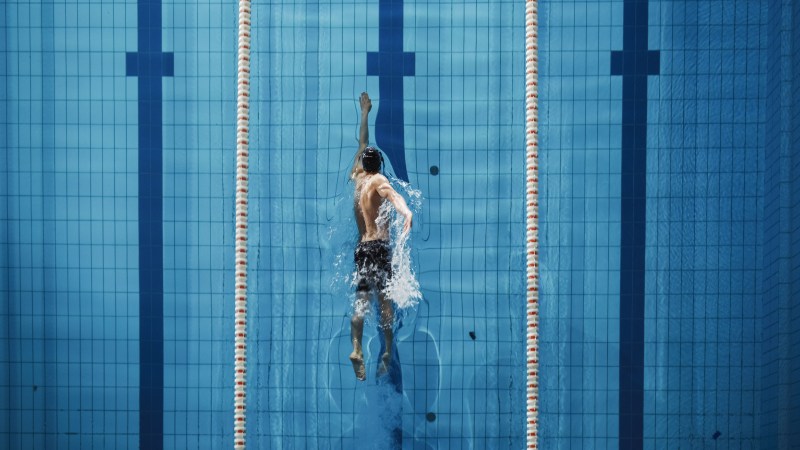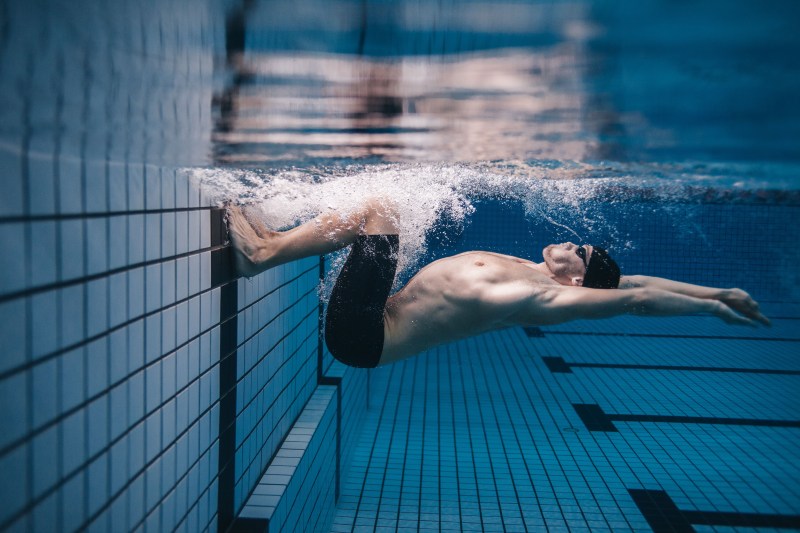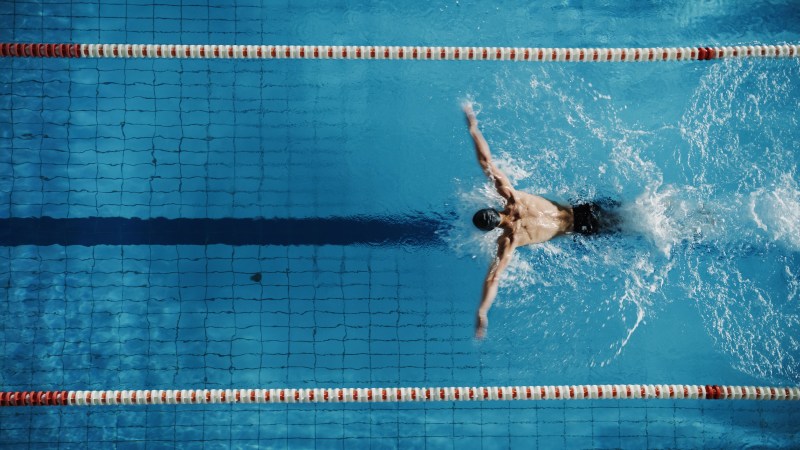
Swimming is not only a great way to cool off during the hot summer months, but it’s also a fantastic full-body workout that can improve cardiovascular fitness and muscle strength. If you’re a beginner looking to dip your toes into the world of swimming, here are some essential tips to help you get started so you can make the most of your aquatic journey. Just don’t forget your speedos!
Read to the end for some fantastic swim workouts for beginners!

Find the right pool
The first step in your swimming adventure is to find a suitable pool. If you don’t have one at home, look for a facility that has a designated area for lap swimming to ensure you have enough space to practice without constantly bumping into other swimmers. Many public pools offer specific times for lap swimming, so check the schedule in advance and plan your visits accordingly.

Learn the basics
You might be wondering, does swimming build muscle? Absolutely. Swimming can even give you a more balanced figure than weight training. But before you dive in, consider taking swimming lessons or enrolling in a beginner’s swimming class. A qualified instructor can guide you through the fundamentals, including breathing techniques, body positioning, and various strokes.
Learning from a professional will not only help you develop good habits from the start, but it will also boost your confidence in the water. While swimming might seem effortless for experienced swimmers, it’s crucial for beginners to learn the basics of proper technique and form.

Start slowly and practice regularly
Don’t expect to become Michael Phelps in a day! It’s essential to start slowly and gradually build your skills and endurance. Begin with short distances and take frequent breaks as needed. As you become more comfortable, increase the distance you swim and reduce the number of breaks. Patience is key, and with consistent effort, you’ll see progress over time.
Like any other physical activity, consistency is vital for improvement in swimming. Aim to swim regularly to build endurance, refine your technique, and increase your confidence in the water. Even if you can only spare a few hours each week, consistent practice will help you develop muscle memory and make swimming feel more natural. Set realistic goals for yourself and celebrate small victories along the way to stay motivated.
Stay safe
Swimming is a wonderful activity that provides countless benefits for physical fitness and relaxation. However, it’s essential to prioritize safety. Here are some important things to bear in mind so you can fully embrace the water with minimal risks:
- Swim in a supervised area: Choose pools that have lifeguards on duty. Their presence ensures immediate assistance in case of emergencies and provides an added layer of security.
- Swim with a buddy: Whenever possible, swim with a friend or a family member so you can look out for each other and provide support if needed.
- Know your limits: Don’t push yourself beyond your capabilities, especially when you’re starting out. Take breaks when you feel tired and avoid swimming alone if you’re not confident in your abilities.
- Respect the rules: Familiarize yourself with the pool rules and follow them diligently. Rules such as no diving in shallow water, no running on the pool deck, and following designated swimming lanes ensure a safe environment for everyone.

Swimming workouts for beginners
U.S. Masters Swimming provides an extensive list of amazing swimming workouts for beginners, but we’ve chosen two great ones to feature. Whatever your fitness goal is, U.S. Masters Swimming has a routine for you.
Swimming in intervals
One of the most helpful in this collection is learning your intervals, which means figuring out how long it takes you to swim 25, 50, and 100 yards.
If you’re asked to swim a distance of 50 yards at an interval of 1:30, that means you have 1 minute and 30 seconds to swim 50 yards. If you do that before the time is up, then you can rest for the remainder of the time, but if you just make 50 yards as time runs out, then there’s no rest period for you. Swimming in intervals is a great way to challenge yourself, so grab a friend and a stopwatch, and let’s dive into this workout!
Warmup:
- 4 sets of 25 yards on an interval of 0:30
- 2 sets of 50 yards on an interval of 1:00
- 1 set of 100 yards on an interval of 2:00
Freestyle
- 4 sets of 50 yards on an interval of 1:15
- 20 sets of 50 yards on an interval of 1:30
Cool down
- 300 yards
Improving your backstroke through drills
Coaches often use drills to improve the quality of a swimmer’s stroke. The goal of a drill is to focus on perfecting the movement, not necessarily racing to the finish line. The idea is to get so used to the correct technique that you’re able to perform it perfectly later once you start speeding up.
Warmup:
- 100 yards freestyle on an interval of 2:00
- Kick for 2 sets of 50 yards with your hands at your sides on an interval of 0:30
- Pull for 100 yards on an interval of 2:00
Workout:
- Kick in the backstroke position for 8 sets of 25 yards on 0:30
- Kick in the backstroke position for 6 sets of 25 yards on 0:30. Keep one arm extended in front of you and the other at your side. Switch arms every set.
- Drill for 4 sets of 25 yards on 0:30, lifting the bottom arm before the top arm pulls under the water.
- Backstroke for 4 sets of 50 yards on 1:00
- Swim with your stroke of choice for 50 yards on 1:00
- Freestyle 2 sets of 200 yards on 3:30
Cool down:
- Swim with your stroke of choice for 8 sets of 25 yards on 0:30
Swimming is a rewarding and enjoyable activity that offers numerous physical and mental health benefits. With a little bit of courage, you’ll be well on your way to becoming a confident swimmer. Embrace the water, have fun, and remember to be patient with yourself as you embark on this exciting journey.
Editors' Recommendations
- These beach body workout tips from a pro will help you get in shirtless shape fast
- 12 tips for healthy habits from TB12 body coach Bryan Hart
- Learn the best stationary bike workouts for every fitness level (from beginner to advanced)
- The gym equipment and exercises it’s totally fine to skip (and what to do instead)
- Your sedentary lifestyle is doing so much damage — here’s what to know and how to get moving




